|
I was fortunate to be permitted to
observe both French and American holidays, so November afforded
me the opportunity to wander a bit further afield. As a
prelude to the 2006 World
Cup and to mark the 40th anniversary of the end of World
War II, the French and Germans announced an exhibition game
on Armistice Day in Paris. I immediately went to the nearest
Carrefour to buy myself a ticket and arranged my transportation
at the local gare. A weekend in Paris seemed like
a nice change of scenery.
|
|
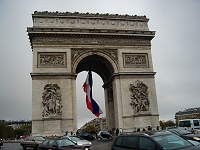
The Arc de Triomphe decked out for
Armistice Day.
|
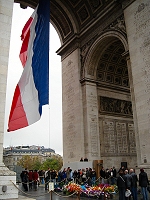
Inside is inscribed with the names
of Napoleonic victories.
|
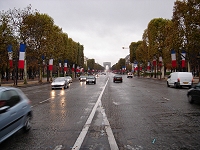
Along the Champs Élysées.
|
|
|
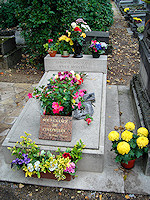
Simone Signore and Yves Montand.
|
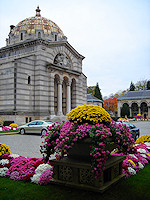
The crematorium.
|
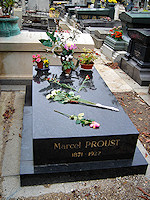
Marcel Proust.
|
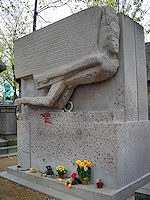
The tomb of Oscar Wilde.
|
|
|
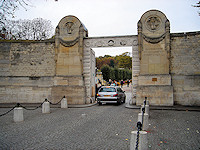
The entrance to Père Lachaise.
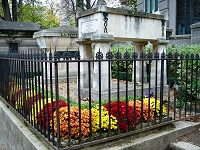
Molière and La Fontaine.
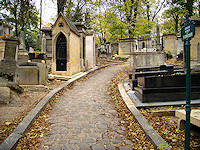
Cobblestone paths traverse the cemetery.
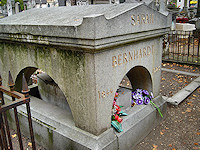
Sarah Bernhardt.
|
Perhaps most people think that visiting
a cemetery is a little morbid, and I’m not particularly
drawn to them either. Still I have always wanted to visit
Père Lachaise on the east side of Paris. Shortly
before the French Revolution, city officials prohibited
further burials in the church graveyards of the city center.
Instead large tracts of land in the surrounding area were
designated for use as well as the mine shafts under southern
Paris. Napoleon established Père Lachaise in 1804,
and even had the remains of the poet Jean de la Fontaine
and the playwright Molière moved there to lend an
air of distinction to the new cemetery. Today it hosts a
number of dead celebrities.
A leading draw for American tourists
especially is the grave of Jim Morrison who died in a Parisian
bathtub in 1971. The grave has become so popular that the
headstone has been stolen or vandalized a number of times,
resulting in heightened security around the cemetery perimeter
and the construction of a fence around the gravesite. Finding
his resting place poses some difficulty as the cemetery
has numerous winding footpaths and the actual grave is wedged
between some tombs. Of course, you know when you’ve found
it because it’s usually surrounded by people. In my case,
there was a young couple blocking the view sharing a set
of earbuds and presumably listening to the Doors. I decided
to come back and try again later.
I roamed around past the graves of
Maria Callas, Balzac, Proust, Yves Montand and his wife
Simone Signoret, Isadora Duncan, Alphonse Daudet (whom I
remembered from my visit to Fontvieille), and Georges Bizet.
I led myself back to the Lizard King, but the couple was
still there, still listening. So I moved on to see the tomb
of Ferdinand de Lesseps, builder of the Suez Canal and initiator
of the Panama Canal. I was fortunate to find it unoccupied
– free of worshiping engineers. I stumbled across the floral
spectacle of Chopin’s grave before finding the resting place
of the voice of France, Edith Piaf.
Perhaps the second most visited grave
is that of Oscar Wilde, the Irish literary giant who moved
to Paris after his release from prison to practice more
freely his alternative lifestyle. Wilde’s crypt is dotted
with lipstick imprints of his many female admirers, and
no doubt some male ones too. As it was getting late, I made
one more pass by Morrison’s grave and finally got a good
look at it.
|
|
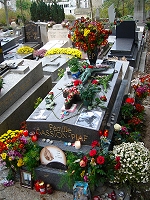
Edith Piaf.
|
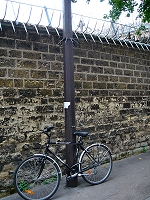
High security.
|
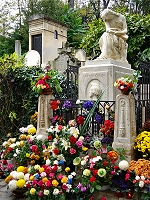
Frederic Chopin.
|
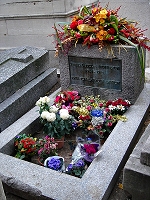
Jim Morrison.
|
|
|
| Following
the theme of visiting sites I had yet to see in my previous
handful of trips to Paris, I bowed to the pressures of pop-tourism
and visited the Église Saint-Sulpice. It played a
key role in the bestselling DaVinci Code in that
it houses the fictional Rose Line, a brass line supposedly
part of the Paris meridian. In fact, the line is a gnomon
meant to help the priests determine the date of Easter each
year. None of this deters the throngs of tourists, however,
so church officials have posted a sign stating:
Contrary to fanciful
allegations in a recent best-selling novel, this is not
a vestige of a pagan temple. No such temple ever existed
in this place. It was never called a Rose-Line. It does
not coincide with the meridian traced through the middle
of the Paris Observatory which serves as a reference for
maps where longitudes are measured in degrees East or West
of Paris. Please also note that the letters P and S in the
small round windows at both ends of the transept refer to
Peter and Sulpice, the patron saints of the church, and
not an imaginary Priory of Sion. |
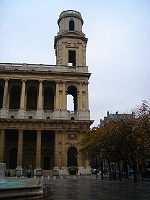
Saint Sulpice.
|
|
|
| In
the month leading up to my trip to Paris, the deaths of
two boys of North African heritage sparked some civil unrest
in the banlieues (outskirts) of the capital. Paris
is surrounded by a ring of low-income housing occupied primarily
by families of immigrants from France’s many former colonies.
Tensions had been simmering for years as the youth of these
areas were subjected to high unemployment rates and persistent
hassling by police. The death of the two boys touched off
a month long series of riots that spread to other major
French cities and ultimately led to President Chirac to
declare a state of emergency.
I had chosen a hotel close to the
stadium which put me in the Saint-Denis region of Paris,
one of the areas that saw its share of the rioting. There
were incidents immediately before and during my stay, but
I saw nothing except for a burned out car. The added security
attributed to the arrival of German fans for the game did
much to quell any insurgence. I spent part of the day in
Saint-Denis walking around town and visiting the Saint-Denis
Basilica. Not a typical stop on the Paris tourist route,
this cathedral was built on the spot where the martyr Denis
eventually died after being beheaded on Montmartre and walking
over two miles while carrying his head. A plaque on the
wall commemorates Joan of Arc’s offering of a suit of armor
following the siege of Paris in 1429, but the basilica is
best known as the final resting place of French monarchy.
The crypt contains the remains of all but three French kings
since the 5th century.
The main event that night was certainly
worth the effort. The French fans filled the Stade de France
to capacity, supporting Les Bleus in both color
and song. The Germans played well and stifled the vaunted
French offense holding them to a scoreless draw. Ballack
was everywhere, and die Mannschaft holds much promise
for the upcoming World Cup.
|
|
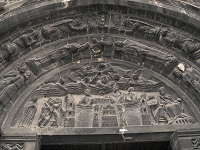
Saint Denis holds communion in a tympanum
over one of the entrances.
|
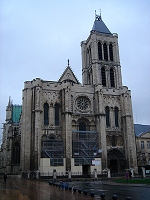
Saint-Denis Basilica.
|
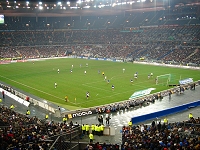
The Germans and French play to a draw.
|
|
|
|
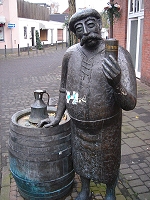
An inviting sculpture marks the site
of the original brewery.
|
Sometime during my stay in France,
I needed to visit a couple of my company’s facilities in
Germany. With Thanksgiving on the horizon, it made sense
to arrange these visits during late November so I could
spend the holidays with my parents. So I spent a few days
in Hamburg and another few in the Ruhr district. I was surprised
to learn that one of the labs was located in Willich where
Hannen Alt, one of my favorite beers was first brewed in
1725. It has since been acquired by Carlsberg and moved
to Moenchengladbach, but the site of the original brauerei
is commemorated in Willich.
|
|
|
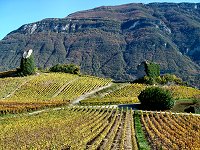
Vineyards lead to the Alpine foothills.
|
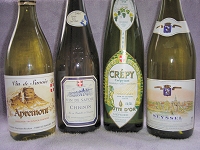
A selection of vins de Savoie.
|
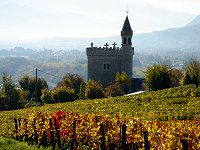
Château de Chignin.
|
|
|
As with other winegrowing parts of
France, the Savoie has its own route du vin – in
fact, it has three. While its wines are not well-known throughout
the world, the Savoie region makes some very nice light
and fruity blends produced from vines nestled against the
nearby mountains. To the west of Chambéry is perhaps
the most famous region where I hiked around the villages
of Chignin, known for producing a dry white, and also Arbin
which bottles a deep red called Mondeuse. On a crisp Autumn
day, the vineyards were a golden brown set against the backdrop
of the Alps. I walked between the vines and stopped at several
vintners to purchase samples of the local specialties. I
was planning to stock my tiny fridge with enough bottles
to last me until Christmas. In August, my father and I stood
at a bar to sample some Apremont with the rest of the husbands
while the wives perused the morning market in Aix-les-Bains.
As it also came from this region, I made sure to pick up
a bottle for later.
Later in the day, I drove the route
that encircles Lac du Bourget passing some picturesque castles
on my way to the region that produces Seyssel, a nice sparkling
white wine. Having already sampled enough for the day, I
thought it prudent to skip the final region situated next
to Lake Geneva. To make up for it, I bought a bottle of
Crépy at a nearby store to drink with dinner that
night. My collection now numbered about eight bottles, and
I set a few aside as gifts for my parents during my trip
in December. My mother was intent on using one bottle for
an authentic Savoyard fondue Christmas Eve.
|
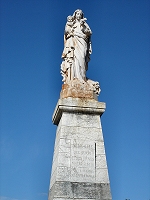
Our Lady of the Fields and Vines.
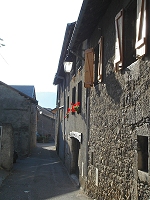
A solitary alley in Arbin.
|
|
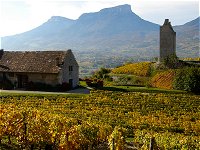
Old stone towers dot the landscape.
|
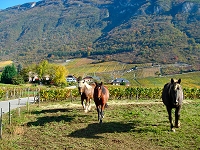
The curious local residents.
|
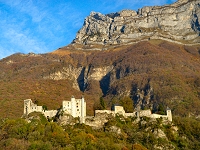
Château de Miolans.
|
|
|

